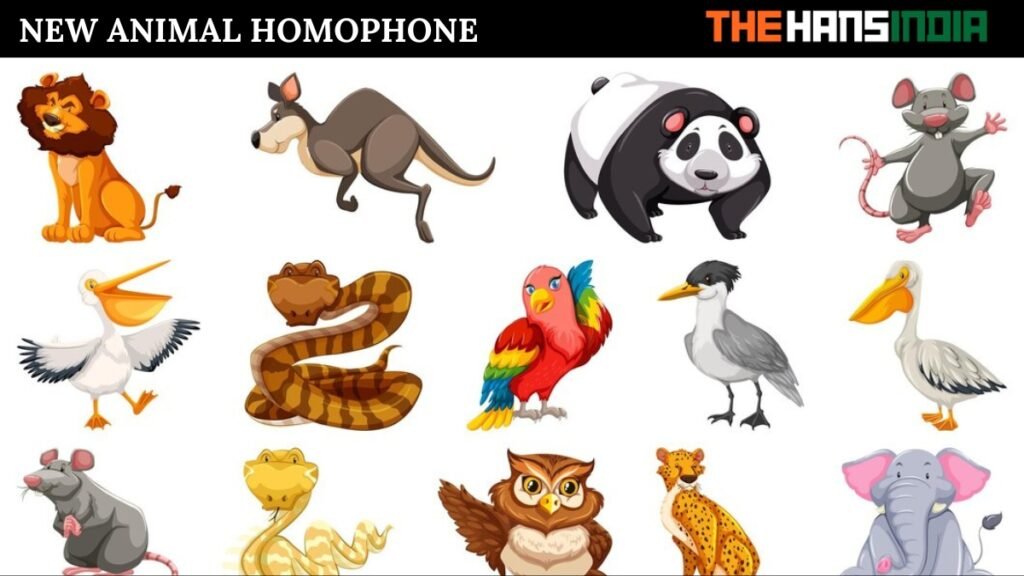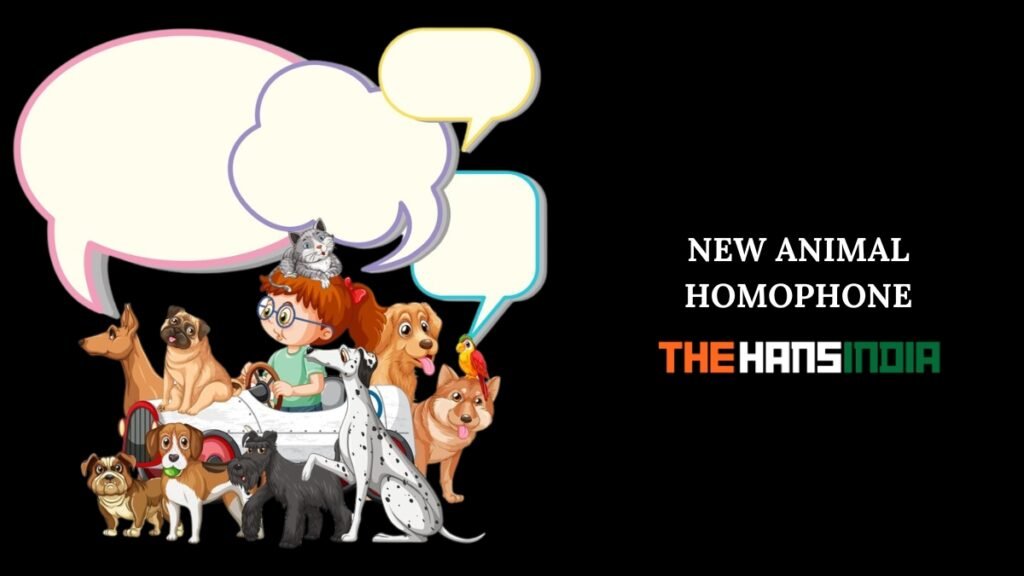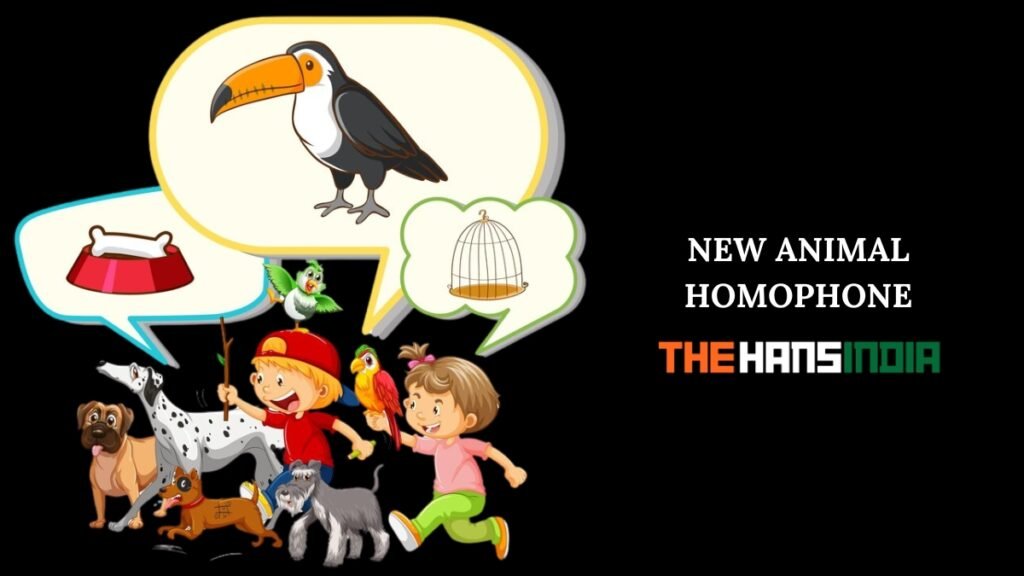Introduction
Language is full of surprises, and one of its most intriguing aspects is homophones—words that sound the same but have different meanings. When these homophones are related to animals, they can lead to a mix of amusement and confusion. Whether you’re a language enthusiast, a writer, or just curious about quirky words, this exploration of new animal homophones will be both informative and entertaining. In this blog post, we’ll delve into the fascinating world of animal-related homophones, highlighting their meanings, usage, and the potential for humorous misunderstandings.
Understanding New Animal Homophones
Homophones are words that sound alike but differ in meaning, spelling, or both. When it comes to new animal homophones, the terms often involve animals or are associated with animals in some way. These words can be tricky because they can lead to misinterpretations if not used carefully. Understanding animal homophones not only helps in improving language skills but also in appreciating the richness of the English language.
Common Animal Homophones
Some animal homophones are well-known and widely used. These include words like “hare” (a type of rabbit) and “hair” (the strands growing from the skin). Although these homophones are familiar, they still cause confusion in writing and conversation. Let’s take a closer look at some common animal homophones:
- Bear/Bare: “Bear” refers to the large mammal, while “bare” means uncovered or naked.
- Deer/Dear: “Deer” is the woodland animal, while “dear” is a term of endearment or something cherished.
- Flea/Flee: “Flea” is a small insect, whereas “flee” means to run away quickly.
- Mare/Mayor: “Mare” is a female horse, and “mayor” is the head of a city government.
These are just a few examples, but the list is extensive and continues to grow as language evolves.
The Emergence of New Animal Homophones
Language is constantly changing, and new homophones emerge as cultures evolve and technology advances. The digital age, in particular, has given rise to some creative and unexpected new animal homophone. These new terms often reflect contemporary life and can be found in online communication, social media, and modern literature.
Some recent additions to the animal homophone family include:
- Ewe/You: “Ewe” is a female sheep, while “you” refers to the person being addressed.
- Seal/Seal: “Seal” can refer to both the marine animal and the act of closing something securely.
- Bass/Base: “Bass” can be a type of fish or a low sound frequency, while “base” is the foundation or starting point of something.
- Gnu/New: “Gnu” is a type of antelope, and “new” refers to something recently made or discovered.
These new homophones are gradually becoming part of everyday language, adding to the richness and complexity of English.
How Animal Homophones Shape Language and Communication
Animal homophones play a significant role in language, often adding a layer of meaning or humor to communication. Writers and poets, in particular, use homophones to create puns, wordplay, and double entendres. These linguistic tools can make language more engaging and memorable, but they also require careful usage to avoid confusion.
For example, the homophones “horse” and “hoarse” sound identical but have vastly different meanings. A sentence like “The hoarse horse could barely neigh” uses the homophones to create a humorous image, relying on the reader’s understanding of the double meaning.
In everyday communication, however, misuse of new animal homophone can lead to misunderstandings. Imagine someone texting, “I saw a bear in the woods, and it was bare!” Without the context, this could be misinterpreted in a humorous or confusing way. Understanding and correctly using homophones is crucial for clear and effective communication.
The Role of Homophones in Literature and Pop Culture
New Animal homophone have a long history of use in literature, from classic poetry to modern-day novels. William Shakespeare, for example, was a master of wordplay and often used homophones to add depth and humor to his plays. In “The Taming of the Shrew,” the character Petruchio uses the homophones “mean” and “mien” in a witty exchange, showcasing Shakespeare’s skill with language.
In pop culture, animal homophones are often used in puns and jokes. Cartoons, for instance, frequently use homophones for comedic effect. A character might say, “I’m feeling a little horse today,” and the visual gag would be a horse with a cold. These playful uses of homophones make them memorable and entertaining, contributing to their longevity in language.
New Animal Homophone in Different Languages
Homophones are not unique to English; they exist in many languages around the world. However, the way they manifest can vary greatly depending on the language’s phonetic and grammatical structure. In some languages, homophones are even more prevalent due to a limited number of sounds, leading to a higher chance of words sounding alike.
For example, in Mandarin Chinese, the words for “horse” (马) and “mother” (妈) are pronounced very similarly, leading to potential misunderstandings if not enunciated clearly. Similarly, in French, “la mer” (the sea) and “la mère” (the mother) are homophones, though context usually clarifies the meaning.
These examples show that new animal homophone are a global phenomenon, with each language bringing its unique twist to the concept. Exploring homophones in different languages can also provide insights into cultural differences and the evolution of language.
Challenges of Animal Homophones in Language Learning
For language learners, homophones can be particularly challenging. Even native speakers sometimes struggle with them, so it’s no surprise that learners of English as a second language (ESL) often find homophones confusing. The similarity in pronunciation but difference in meaning can lead to mistakes in both spoken and written language.

For instance, a language learner might write “bare” when they mean “bear,” leading to sentences that don’t make sense. Teaching homophones requires a focus on context, pronunciation, and spelling, as well as lots of practice. Language teachers often use visual aids, word games, and mnemonic devices to help learners distinguish between homophones.
Moreover, understanding homophones is crucial for achieving fluency in a language. They are a common feature in everyday speech, and mastering them can greatly improve a learner’s comprehension and communication skills.
Practical Tips for Avoiding Confusion with Animal Homophones
To avoid confusion when using animal homophones, it’s important to consider the context in which the word is being used. Here are some practical tips:
- Context Clues: Always pay attention to the surrounding words and sentences to determine the correct meaning of a homophone.
- Spell Check: Use spell-check tools, but be aware that they might not catch homophone errors since both words are correctly spelled.
- Practice: Regularly practice writing sentences with homophones to reinforce their correct usage.
- Read Aloud: Reading sentences aloud can help you hear the difference and ensure you’re using the correct word.
- Mnemonics: Create mnemonic devices to help remember the different meanings of homophones. For example, “The bear bears a heavy burden,” can help you recall that “bear” refers to the animal.
By following these tips, you can minimize errors and communicate more effectively, especially in writing.
How Technology Is Influencing New Animal Homophone
With the advent of technology, especially texting and social media, new homophones are constantly being created. Abbreviations and slang terms often give rise to homophones that might not have existed before. For instance, “gr8” (great) and “ate” sound the same but have different meanings.
Voice recognition software and autocorrect features can also lead to unintended homophone substitutions, often with humorous or confusing results. As technology continues to evolve, it’s likely that new animal homophone will continue to emerge, reflecting changes in how we communicate.
The Impact of Animal Homophones on Branding and Marketing
In branding and marketing, homophones can be a double-edged sword. On one hand, they can make brand names catchy and memorable. On the other hand, they can lead to confusion if not chosen carefully. For example, a brand name like “Bare Essentials” might evoke natural, minimalist products, but it could also be confused with “Bear Essentials,” which might suggest rugged, outdoor gear.
Marketers need to consider the potential for homophone confusion when naming products, creating slogans, or developing ad campaigns. A clever homophone can be an asset, but it must be easy for consumers to understand and remember.
Case Studies: Successful Use of Animal Homophones in Business
Some businesses have successfully used animal homophones to their advantage. Let’s look at a few examples:
- Bear Naked Granola: This brand uses the homophone “bear” to create a playful and memorable name. The word “naked” emphasizes the natural, unprocessed nature of the product, while “bear” suggests a hearty, satisfying snack.
- Mane n’ Tail: This brand of hair care products uses the homophone “mane” (referring to a horse’s hair) to create a strong connection to healthy, shiny hair, playing on the idea of luxurious locks akin to a horse’s mane.
These examples show how a well-chosen homophone can contribute to a brand’s identity and appeal.
Common Mistakes When Using New Animal Homophone
Even seasoned writers and speakers can make mistakes with animal homophones. Some of the most common errors include:
- Confusing similar-sounding homophones: For example, mixing up “moose” and “mousse” can lead to awkward sentences.
- Using the wrong homophone in a sentence: This often happens when typing quickly or relying on autocorrect.
- Failing to recognize a homophone exists: Not realizing that words like “seal” can have multiple meanings might lead to unintentional puns or misunderstandings.
Awareness and careful proofreading can help prevent these mistakes.
The Future of Animal Homophones in Language
As language continues to evolve, so will homophones. The rise of digital communication, globalization, and cultural exchange will likely lead to the creation of new homophones, including those related to animals. These new additions will enrich the language, offering fresh opportunities for wordplay, creativity, and expression.

Writers, educators, and language enthusiasts will continue to explore and document these changes, ensuring that the fascinating world of homophones remains vibrant and relevant.
Conclusion
New Animal homophone are a captivating aspect of language that offer endless possibilities for creativity, humor, and expression. Whether you’re a language lover, a writer, or just someone who enjoys playing with words, understanding and using these homophones can enrich your communication skills and deepen your appreciation for the nuances of English. As new homophones continue to emerge, they remind us of the ever-evolving nature of language and the joy of discovering new ways to express ourselves.
FAQs
What is a homophone?
A homophone is a word that sounds the same as another word but has a different meaning, and sometimes a different spelling.
Why are animal homophones important?
New animal homophone are important because they add complexity to language, allowing for wordplay, puns, and creative expression.
Can homophones be confusing?
Yes, homophones can be confusing, especially if the context is unclear. This is why it’s important to use them carefully in both writing and speech.
How can I avoid mistakes with homophones?
To avoid mistakes, pay attention to context, use spell-check tools, practice regularly, and read your sentences aloud.
Are there homophones in other languages?
Yes, homophones exist in many languages, though they may be more or less common depending on the language’s structure and sounds.
How are new homophones created?
New homophones can emerge from changes in pronunciation, slang, and technology, as well as through cultural and linguistic evolution.


